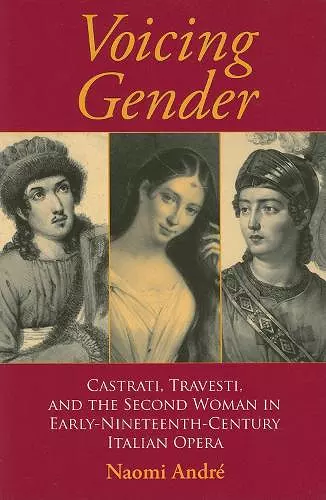Voicing Gender
Castrati, Travesti, and the Second Woman in Early-Nineteenth-Century Italian Opera
Format:Paperback
Publisher:Indiana University Press
Published:13th Feb '06
Should be back in stock very soon

Builds on foundational work in feminist musicology while integrating a more conventional approach to historical musicology
The early 19th century was a period of acute transition in operatic tradition and style, when time-honoured practices gave way to the developing aesthetics of Romanticism, and the heroic, the masculine, and the feminine were profoundly reconfigured. This book traces the development of female characters in these first decades of the century.
The early 19th century was a period of acute transition in operatic tradition and style, when time-honored practices gave way to the developing aesthetics of Romanticism, the rise of the tenor overtook the falling stars of the castrati, and the heroic, the masculine, and the feminine were profoundly reconfigured. These transformations resounded in operatic plot structures as well; the happy resolution of the 18th century twisted into a tragic 19th-century finale with the death of the helpless and innocent heroine—and frequently her tenor hero along with her. Female voices which formerly had sung en travesti, or basically in male drag, opposite their female character counterparts then took on roles of the second woman, a companion and foil to the death-bound heroine rather than her romantic partner. In Voicing Gender, Naomi André skillfully traces the development of female characters in these first decades of the century, weaving in and around these changes in voicings and plot lines, to define an emergent legacy in operatic roles.
"In presenting the concept of the period ear as a way for today's audiences to hear the voices of the primo ottocento, André (Andre) (Univ. of Michigan) offers a solution to the problematic study of historical performance. The author differentiates between the various onstage female types and traces how a woman's voice represent[ed] both male and female characters during the time that opera diverged from supreme castrati reign and moved toward the era of the Romantic heroine. The opening chapters illustrate the prevailing fashion for castrati versus travesti (males in drag) early in the century, with some reference to more familiar pants role territory and a close study of how opera characters hear female voices onstage and how they respond musically, textually, and dramatically. A short interlude adopts the Bakhtinian hybrid as a model for understanding the 19th—century audience's approach to hearing gender. The first hint of self—confessed diva worship also appears here, in the form and voice of Maria Malibran. This widens in the final chapter to an in—depth study of soprano Giuditta Pasta, specifically of the title roles she created in Medea in Corinto, Norma, and Anna Bolena. Summing Up: Recommended. Graduate students, researchers, and faculty."—V. Vaughan, formerly, Oberlin College, Choice, February 2007
"Voicing Gender is essential reading for those hoping to gain a deeper understanding of the bel canto tradition. André's meticulous research, clear prose, and insightful commentary will increase our appreciation of a wide variety of works."—OPERA JOURNAL
"André's study provides an exciting new perspective on the Romantic heroine's relationship to her operatic ancestors. Unwilling to cast a diva as devoid of agency and a mere product of growing misogyny among composers and librettists, André weaves a fresh historical narrative that makes sense of women's role as interpreter of primo ottocento opera. . . . As Irigaray might implore, Open your ears—don't open them simply.Vol. 13 2009"—STEPHANIE JENSEN-Moulton, Women & Music
"In presenting the concept of 'the period ear' as a way for today's audiences to 'hear' the voices of the primo ottocento, André . . . offers a solution to the problematic study of historical performance. The author differentiates between the various onstage female types and traces 'how a woman's voice represent[ed] both male and female characters' during the time that opera diverged from supreme castrati reign and moved toward the era of the Romantic heroine. . . . Recommended."—Choice
ISBN: 9780253217899
Dimensions: unknown
Weight: 354g
248 pages